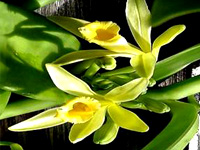Vanilla (Vanilla planifolia)

Introduction:
It is used as a flavouring agent and also in perfumery. It does not need much investment. Hence, can be cultivated as crop with minimum expenses reaping maximum profit. Keeping in view the increasing demand for natural vanilla, commercial production is required to be increased.
Source:
Vanilla consists of curved, fully-grown, unripe fruits of climbing orchid- Vanilla planifolia, belonging to family Orchidaceae.
Climate:
Climate plays an important role in vanilla cultivation. Vanilla requires moderate sunshine and humidity and grows best in 50 percent shade. Vanilla plant grows well in the regions where there is abundant rainfall.
Soil:
It grows well on wet and looses soils and sloppy land with laterite soil. It doesnot withstand water logging. Hence, it requires soil with good water drainage property.
Temperature:
Ideal temperature for vanilla cultivation if between 00 to 280 C is ideal.
Cultivation details:
Time of cultivation:
Suitable time for planting the cuttings is either before onset of monsoon i.e. in the month of May- June or after rainy season i.e. in the month of October- November.
Propagation:
It can be propagated widely by using cuttings of the plant or also by tissue culture method, which is not used widely.
Land Preparation and planting:
The land has to be well prepared by mixing soil with manure. Then the cuttings of the stem, which are about 2 to 2.5 meters in length and 5 cm. in diameter, is planted in the fields. If small cuttings are obtained, they are raised on nursery beds and then transplanted in the farm.
The process of planting should be completed before the onset of monsoon or after monsoon in pits with the spacing of 2.5 meters between. After planting, the base is covered with thin layer of soil to maintain moisture in the root area. Then, it develops root within 5- 8 weeks.
Irrigation:
It should be irrigated well at regular intervals, as it is a surface feeder crop. More attention should be paid during non-rainy seasons. Care should be taken for irrigation, till the crop establishes in the field.
Fertilizers:
Use of inorganic fertilizers is avoided in vanilla cultivation. Neem cake, castor and poultry manure can be used for manuring.
Pruning:
Pruning should be done when the vines are 3 to 4 years old. The operation is carried out during September- October, followed by water stress for a month, this helps in good flowering of plants.
Flowers and pollination:
The vines start flowering between December- March. When the plant is 4.5 to 5 years old, the inflorescence appears in the leaf axil bearing about 20 -25 flowers. The flowers take upto 40- 50 days to open. If the flowers are pollinated successfully, beans are formed, otherwise the flowers shed off after 4-5 days.
Artificial pollination:
The pollination is done manually and after the rainy season. This process should be carried out in the morning time, when the humidity level is high.
Harvesting:
The beans take about 10 months to become mature and when it becomes mature the tip of bean changes colour and turns golden yellow, which is the exact period for harvesting the beans.
Yield:
Vanilla is a high-income crop, provided proper care during the cultivation is taken. On an average, 50- 60 kg./ ha. Of seeds are produced annually.
Approximate economics for cultivation:
Land preparation
Nursery raising
Transplanting
Fertilizers/ manures
Irrigation
Plant protection
Miscellaneous
(Labour, artificial pollination)
Harvesting |
2000
1500
1500
2000
1200
1200
3000
2000 |
Total |
Rs. 14, 400 |
Returns:
The estimated cost of curing unit for processing 100 kg. green beans is Rs. 10,000/-
- Cultivation of medicinal plants by Dr. C.K.Kokate, Dr. A.S.Gokhle and Prof. S.B.Gokhle
- Cultivation of medicinal and aromatic rops by A.A.Farooqi and B.S.Sreeramu.
|

